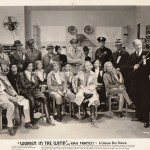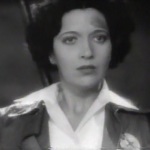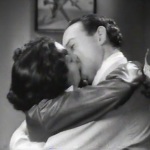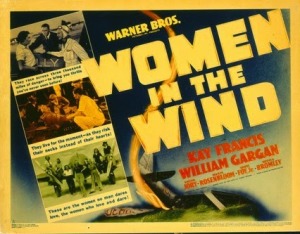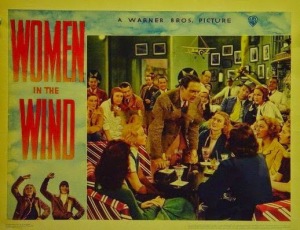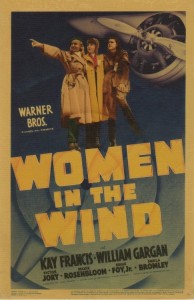Cast:
Kay Francis … Janet Steele
William Gargan … Ace Boreman
Victor Jory … Dr. Tom ‘Doc’ Wilson
Max ‘Slapsie Maxie’ Rosenbloom … ‘Stuffy’ McInnes
Eddie Foy Jr. … Denny Corson
Sheila Bromley … Frieda Boreman
Eve Arden … Kit Campbell
Charles Anthony Hughes … Bill Steele
Frankie Burke … Johnnie
Spencer Charters … Farmer Henry Dickens
Vera Lewis … Farmer’s Wife
William Gould … Mr. Palmer, the Banker
Gordon Hart … Drew, Air Races Official
Ila Rhodes … Joan Bridges, an Aviatrix
Directed by John Farrow.
Produced by Mark Hellinger & Bryan Foy.
Based on the novel by Frances Walton.
Screenplay by Lee Katz & Albert DeMond.
Art Direction by Carl Jules Weyl.
Musical Direction by Leo F. Forbstein.
Gowns by Orry-Kelly.
Cinematography by Sid Hickox.
Film Editing by Thomas Pratt.
A Warner Bros. Picture.
Released April 13, 1939.
Box Office Information:
Cost of Production: $301,000
Domestic Gross: $262,000
Foreign Gross: $88,000
Total Gross: $348,000
(See the Box Office Page for more info.)
Background:
“The last film under Kay’s contract, Women in the Wind, was mediocre and a sad finale to her days at Warner Brothers,” Lynn Kear and John Rossman, Kay Francis: A Passionate Life and Career.
By the time Women in the Wind was completed through its rushed production and released under the B unit for Warner Bros., Kay Francis accomplished a lot. She had emerged as the top box office sensation for the studio, earning more than Bette Davis, James Cagney, Dick Powell, and Paul Muni. She had earned—and continued earning through the Women in the Wind shoot—one of the highest-paid salaries in Hollywood, $5,250 weekly. She’d been named the sixth most popular leading lady in the entire movie industry by Variety in 1937, and “Box office Poison” the following year by the Independent Film Journal.
Hell-bent on getting Kay Francis to quit (firing her would have cost the studio too much money in legal fees), Jack and Harry Warner tossed her to producer Brian Foy, head of their B-picture unit, and had Foy give her the works. She made three B pictures released in 1938 for Foy, a gangster tale with Humphrey Bogart with the producer which didn’t see release until the following year, and this tale of a female pilot who’s determined to win a lavish cash prize in an air derby to pay for her invalid brother’s operation.
Originally (and strangely for a studio so ready to get rid of her), Warner Brothers had announced Kay as the star of The Gay Nineties, a lavish musical to be directed by Lloyd Bacon and costar Dick Powell, Ann Sheridan, Humphrey Bogartm Olivia de Havilland, and George Brent. Unfortunately, Gay Nineties was never given the green light, and production on Women in the Wind continued with Kay Francis as the featured star amongst unknown names.
But Women in the Wind isn’t that bad of a film. Actually, it’s pretty fun. There’s some great flying scenes, and a suspense about “is Kay or isn’t Kay going to win this thing and save her brother?” Of course we Kay fans know she’s going to win the money and save her brothers life, but the thought of her not winning keeps us on our toes for a movie most would consider predictable and pointless. But forget the critics who want nothing to do but get on their knees for Marlon Brando and Spencer Tracy, Women in the Wind is probably the best movie Kay made under the supervision of Brian Foy, an expert at producing campy low-budget programmers.
Production on the film started September 2, 1938 and concluded on the 27. Additional scenes were shot in December, and this movie was held from release until April 1939 to give audience members enough time to watch Kay’s other B products to be released: Secrets of an Actress (released in October, 1938), Comet Over Broadway (December, 1938), and King of the Underworld (January, 1939).
On the set of Women in the Wind, Kay gave an interview with journalist Dick Mook for Photoplay’s March 1939 issue. Titled, “I Can’t Wait to be Forgotten,” she vented her frustrations with life and Hollywood in a frank interview while struggling against the tears running down her face. When Mook suggested to Kay that at least she’d be leaving Warner Brothers—and the screen for good since she originally announced that Women in the Wind would be her last film—she snapped back with an honest response:
“Don’t kid me, darling. A year ago, yes. But not now. The parade is passing me by and I don’t care. Perhaps I’d have been better off if I had fought for better stories, but the end didn’t justify the means. I’d have been suspended and the time I was under suspension would have been added to the end of my contract. So, instead of being free now, I would probably have had another year or two to go. And, even then, I’d have no guarentee the stories I picked would have been any better. Even if they had been, the only difference would have been that I would be retiring in a blaze of glory instead of more or less inconspicuously—and this is the way I want it. I’ll be forgotten quicker this way.”
Thank God Carole Lombard stood in the way of Kay and giving up. Lombard is larrgely responsible for Kay continuing on with her movie career, and her legendary comeback as “Maida Walker” in In Name Only(1939).
Women in the Wind was released to unenthusiastic reviews, but was a potent box office success; maybe not on the level of I Found Stella Parish (1935) or Give Me Your Heart (1936), but it made an impressive profit which reminded some at the studio why she deserved her lush salary—which was higher than that of any other Warner Brothers star of the era.
Kay Francis returned to the studio only once, for Always in My Heart (1942). It was the end of an era overlooked today by historians. It’s easier to just go on about Bette Davis fighting Jack Warner instead of actually studying history and realizing that there were people far more important than her. Numbers don’t lie.
Below: Kay places first in the air race.
Webmaster’s Review
We first see a plane riding high in the sky. A newspaper headline appears onscreen, “ACE BOREMAN DUE SOON, CIRCLING THE WORLD WITHIN EIGHTY HOURS. Flyer nears New York; Record Well in Hand.”
Ace and “Stuffy,” his buddy, arrive in New York with a parade which rivals that any president ever had in his honor. Sitting at home, Janet Steele and her brother Bill are listening to Ace’s parade over the radio. Bill was a phenomenal pilot of his time, and they make hopeful remarks about his returning to the cockpit, but it’s unlikely. He was involved in a terrible accident a while back which ruined his legs.
Reading the paper while talking with Bill, Janet notices an ad, “Entries Swell in Women’s Air Race. Los Angeles Flying Association Announces $15,000 First Prize in the Women’s Air Derby.”
Outside Dr. Wilson is talking to a banker who gives him the bad news that a loan for Bill’s operation can not be conceived. They need a specialist from the east, but Janet tells him to forget the banker and get him on the phone. She’s got a plan to get some money.
Janet takes a walk around an airport and runs into her old friend, Kit Campbell, who’s been flying for Ace Boreman. Kit introduces Janet to Ace, but tells her not to let on that she knows how to fly. Ace and Janet lock eyes and flirt immediately, and he agrees to take her to the cockpit and show her around.
Playing stupid, she purposely drops her purse outside of a window. This is a great example of Kay’s comedic abilities. When he goes to pick it up, she starts the plane and takes off—in heels, too. She does some risky stunts the scare the crap out of him. “Hey, look at that,” observes Stuffy. “Who says she couldn’t fly?”
“Turn off that motor!” Ace shouts. “Turn off that plane and get out in a hurry!”
“Some plane!” Janet charmingly says stepping down.
“And some crust. Get away from here before my temper really gets the better of me.”
“You’re not peeved, are you?”
“No. It’s a habit of mine to let any screwball take my plane up for acrobatics. Here’s your purse, sorry to have known you.”
It’s a funny moment with Kay really enjoying the whole thing. She presses Ace’s emotions by hiding in his office when he storms in. He forgives her and they talk for hours, with him agreeing that he can fly that plane, “Polly,” anytime she wants. It’s his fastest plane, and he plans to retire her to the Smithsonian Institute.
Making a phone call to Dr. Wilson about Boreman’s allowing of her to fly “Polly” in the air derby, she overhears Ace telling stuffy that it’s all a gag. “Fly ‘em and forget ‘em” Ace suggests to Stuffy. He’s not allowing her to fly that plane in the woman’s air derby.
A few days later, she’s flying Ace back to her chicken ranch. He’s a little amused, but suspicious when she says she likes to “fry ‘em and forget ‘em.” Once there, Ace is introduced to Dr. Wilson, who informs Ace that Bill—and old friend of his who was the one who taught him to fly—is in need of an operation. Ace is a taken back by Janet’s set up. Now he really can’t deny Janet’s access to “Polly” for the woman’s air derby.
Before he gets ready to take Janet out to dinner, Ace gets a call from Frieda, who is legally still his wife. The slime-sucking creep insists that she’s going to fly “Polly” in the air derby, not Janet. When ladies meet, they exchange bitchy remarks and evil stares. Janet realizes that there’s no way she can fly “Polly.”
Denny Corson arrives at the airport to see Ace. Denny just beat Ace’s record within days of Ace’s record-breaking flight. Denny wants to apologize, and allows Ace to use the plane that he used to beat the record. Corson’s plane is the only one faster than “Polly,” and Janet is going to fly it and win.
Janet’s the first to arrive in Wichita, Kansas, the checkpoint in the derby. She coldly acknowledges Ace’s presence when he congratulates her. She has yet to know it was him who got her Denny’s plane. Frieda places second, and, since the bitch can’t play fair, has to get someone to screw with the gas tank in Janet’s plane.
Because she placed first, Janet gets a ten minute start before the rest of the girls. Her advantage is sidelined by Kit’s crash into the ground. Luckily, she’s okay, and when Janet decides to stay with her, Kit informs her to “get in the plane, ya dope.”
Back in the air, Janet reads a letter Kit handed to her. It reveals that it was Ace who got her the plane, but is soon distracted by her plane which is out of fuel. She lands at a remote farm, takes some gas, fixes the nozzle on the tank, then takes off again.
The race between Frieda and Janet becomes neck and neck. When it becomes clear one of Janet’s landing wheels is wrecked, Frieda actually slows down to let her know about the potentially dangerous landing she’s about to make. Because of her actions, Frieda loses the race to Janet, though she wouldn’t have won anyway. Janet had the better plane, and she would have won fair and square had Frieda not intervened.
Back in Ace’s office, Janet hears that Kit’s alright, and that the Mexican divorce Frieda got year back, which they didn’t think was legal, is official. Ace is free to marry Janet, who is now able to save her brother’s life.
This is really great fun, on the level of Girls About Town (1931) when it comes to putting me in a good mood. I don’t know why I like this film so much, I just do.
Yet again, Kay isn’t required to do a thing in this movie, which is how this reviewer likes to see her at times. She just goes with the flow, and her being there makes up for a lack of acting needed in this quickie. For an aviatrix, her permanent is way to fancy for a woman of her economic background, her clothes are too elaborate, and she seems to live in a trailer placed on a chicken farm…talk about bizarre situations! Still, that’s how fans of Kay Francis liked to see her, and, as Turner Classic Movies host Robert Osborne has said many times, people weren’t supposed to ask questions about Kay Francis movies.
I’ll always consider this one of her best formula films, and, honestly, this is just as good entertainment for me as One-Way Passage or Jewel Robbery.
Call me crazy, but I guess I’m just that much of a fan.
Sheila Bromley is completely despicable as Frieda, which is how she should be. Her part as the blonde vixen rivals Kay’s vamp roles, yet, in the end, she has a change in attitude, allowing Kay to win more than just the race.
William Gargan doesn’t have much of a part, but he has some great lines himself when Kay first steps down from that plane.
Max Rosenbloom had been one of the foremost boxing champions in the country in the early 1930s. The last thing one would expect him to do is end up in a Kay Francis movie. But he did, and is really a scene stealer as Stuffy. Another one is Frankie Burke, a James Cagney look-a-like, who plays Johnnie, Ace’s office boy. Both Rosenbloom and Burke have great lines and use them to their full advantage.
Eve Arden was an excellent character actress. She’s hysterical in every film I can remember seeing her in. I especially like when Kay rushes to her side after the crash, and Eve informs her to “get back in the race ya dope!”
So what if this movie was a B programmer; it’s more entertaining than half of the “A” product being made by Warner Brothers in the 1930s. I don’t care what anyone has to say, I’ve always considered this a Kay Francis-must-see.
Below: Max ‘Slapsie Maxie’ Rosenbloom was one of the greatest boxers of his generation. Odd, but interesting, that he ended up in a Kay Francis movie. Here he is in a behind the scenes shot.
Vintage Reviews:
Written by Frank S. Nugent.
Published April 13, 1939 in the New York Times.
Caught in the backwash of “Tailspin,” which flew over much the same terrain, the Palace’s “Women in the Wind” never quite gets off the ground, even though most of its action is in the sky. It is another commonplace little fiction embroidered upon the Powder Puff Derby, the annual transcontinental race for the women fliers, with Kay Francis as the girl who simply has to win the race to get money for her brother’s operation. Everything happens according to formula, including the spiteful rival’s last-minute change of heart which not only permits Miss Francis to land her crippled plane safely but William Gargan as well. Although Frank Walton wrote the book, we suspect a few changes: he never would have sanctioned stunting over an airport, even by so charming a flier as Miss Francis.
Lobby Cards:



